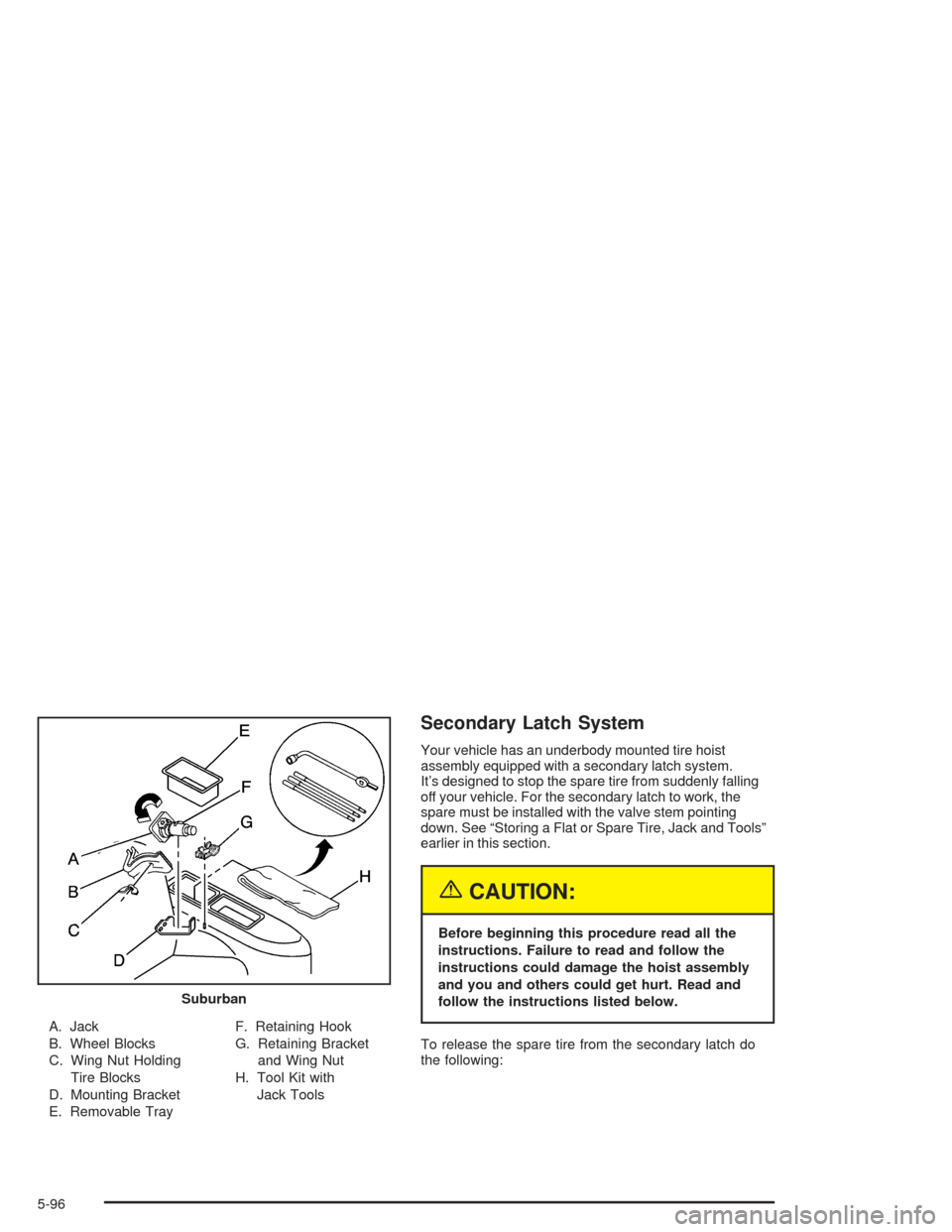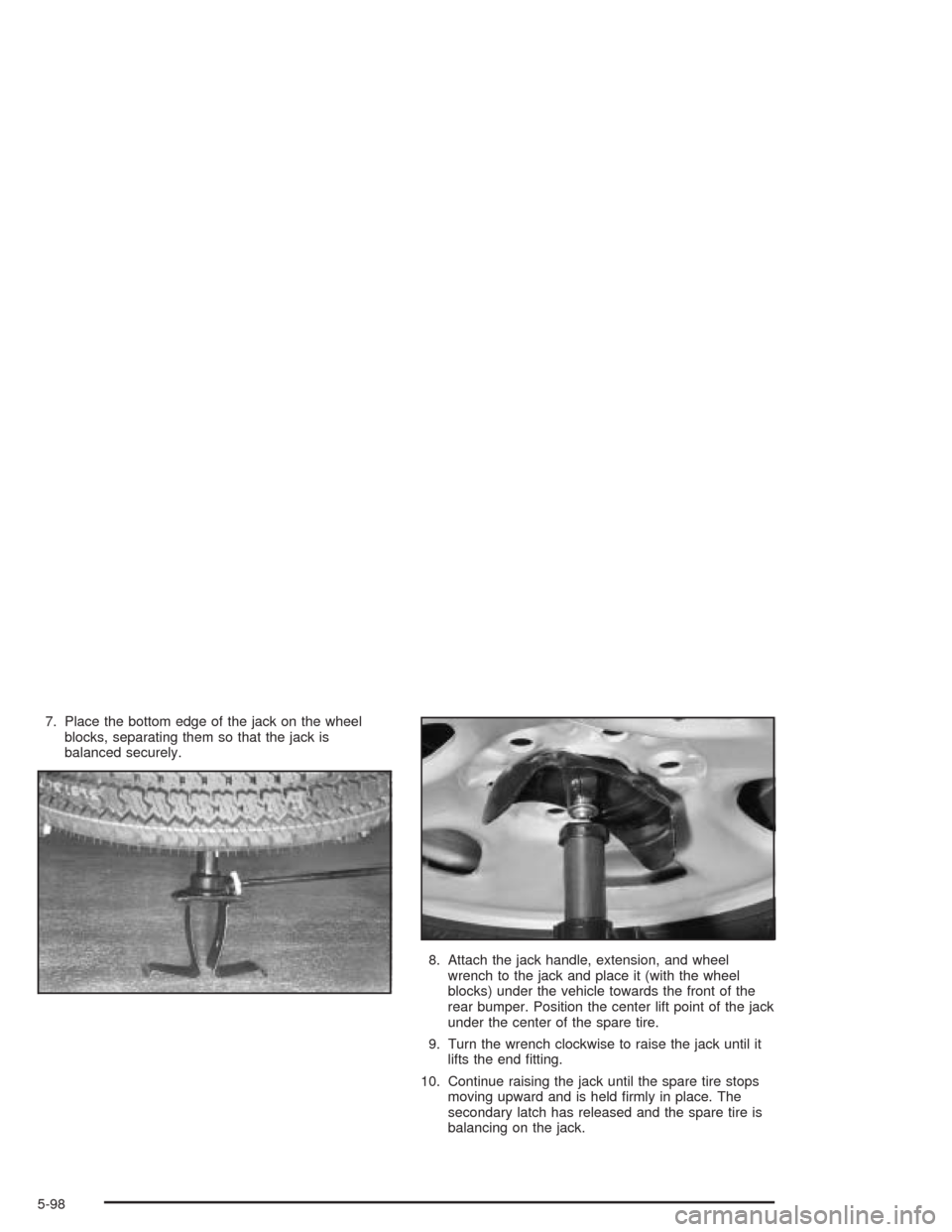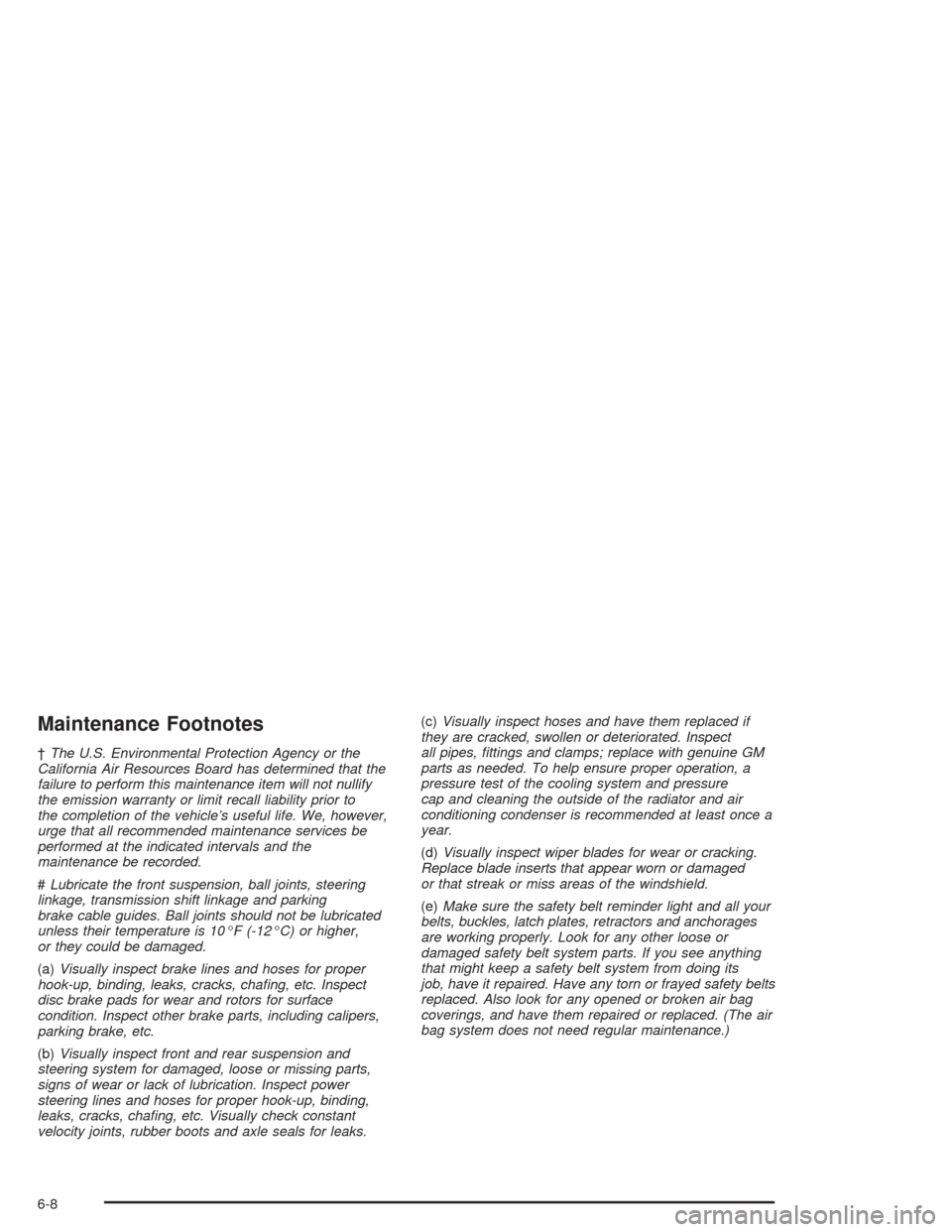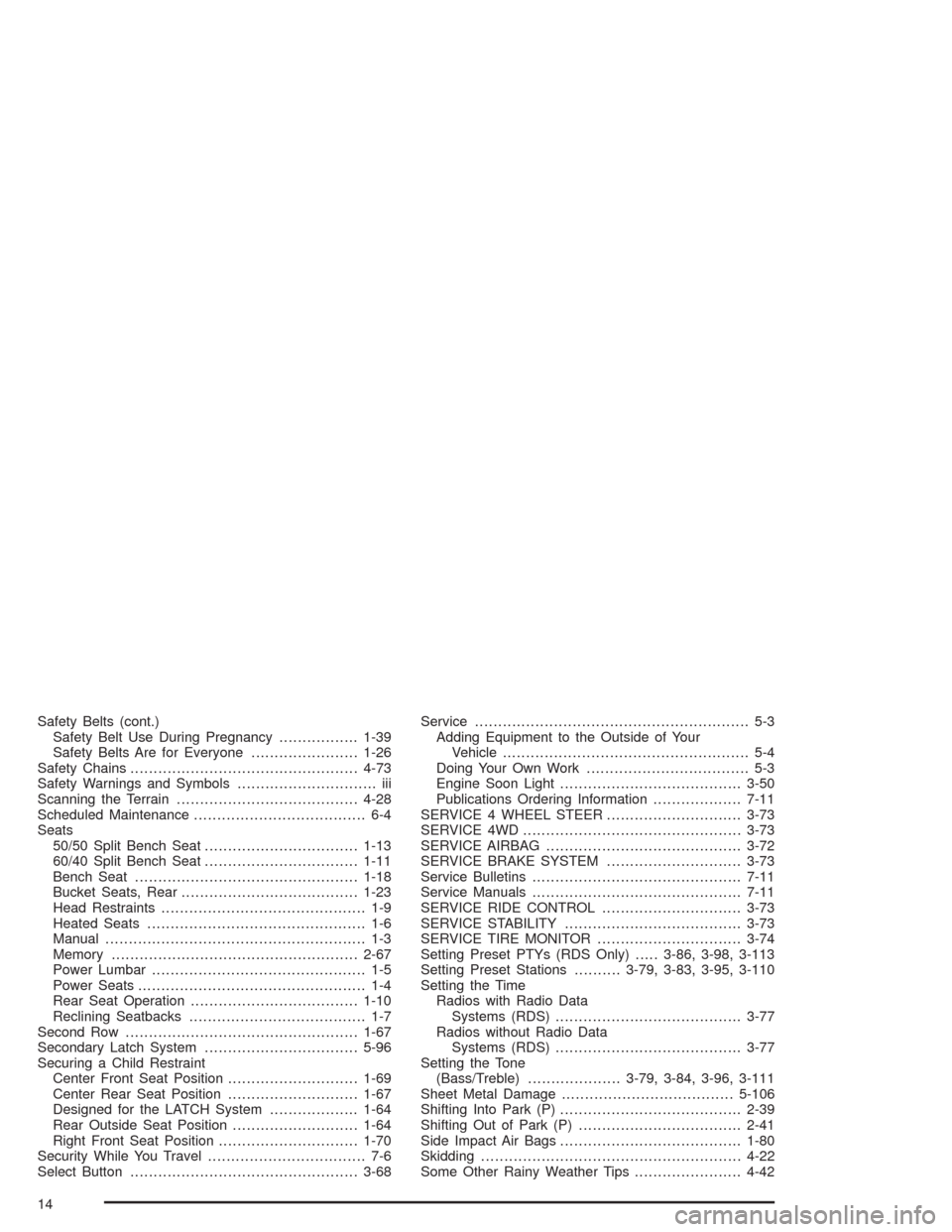2004 CHEVROLET TAHOE LATCH
[x] Cancel search: LATCHPage 482 of 556

A. Jack
B. Wheel Blocks
C. Wing Nut Holding
Tire Blocks
D. Mounting Bracket
E. Removable TrayF. Retaining Hook
G. Retaining Bracket
and Wing Nut
H. Tool Kit with
Jack Tools
Secondary Latch System
Your vehicle has an underbody mounted tire hoist
assembly equipped with a secondary latch system.
It’s designed to stop the spare tire from suddenly falling
off your vehicle. For the secondary latch to work, the
spare must be installed with the valve stem pointing
down. See “Storing a Flat or Spare Tire, Jack and Tools”
earlier in this section.
{CAUTION:
Before beginning this procedure read all the
instructions. Failure to read and follow the
instructions could damage the hoist assembly
and you and others could get hurt. Read and
follow the instructions listed below.
To release the spare tire from the secondary latch do
the following: Suburban
5-96
Page 484 of 556

7. Place the bottom edge of the jack on the wheel
blocks, separating them so that the jack is
balanced securely.
8. Attach the jack handle, extension, and wheel
wrench to the jack and place it (with the wheel
blocks) under the vehicle towards the front of the
rear bumper. Position the center lift point of the jack
under the center of the spare tire.
9. Turn the wrench clockwise to raise the jack until it
lifts the end �tting.
10. Continue raising the jack until the spare tire stops
moving upward and is held �rmly in place. The
secondary latch has released and the spare tire is
balancing on the jack.
5-98
Page 514 of 556

Maintenance Footnotes
†The U.S. Environmental Protection Agency or the
California Air Resources Board has determined that the
failure to perform this maintenance item will not nullify
the emission warranty or limit recall liability prior to
the completion of the vehicle’s useful life. We, however,
urge that all recommended maintenance services be
performed at the indicated intervals and the
maintenance be recorded.
#Lubricate the front suspension, ball joints, steering
linkage, transmission shift linkage and parking
brake cable guides. Ball joints should not be lubricated
unless their temperature is 10°F (-12°C) or higher,
or they could be damaged.
(a)Visually inspect brake lines and hoses for proper
hook-up, binding, leaks, cracks, cha�ng, etc. Inspect
disc brake pads for wear and rotors for surface
condition. Inspect other brake parts, including calipers,
parking brake, etc.
(b)Visually inspect front and rear suspension and
steering system for damaged, loose or missing parts,
signs of wear or lack of lubrication. Inspect power
steering lines and hoses for proper hook-up, binding,
leaks, cracks, cha�ng, etc. Visually check constant
velocity joints, rubber boots and axle seals for leaks.(c)Visually inspect hoses and have them replaced if
they are cracked, swollen or deteriorated. Inspect
all pipes, �ttings and clamps; replace with genuine GM
parts as needed. To help ensure proper operation, a
pressure test of the cooling system and pressure
cap and cleaning the outside of the radiator and air
conditioning condenser is recommended at least once a
year.
(d)Visually inspect wiper blades for wear or cracking.
Replace blade inserts that appear worn or damaged
or that streak or miss areas of the windshield.
(e)Make sure the safety belt reminder light and all your
belts, buckles, latch plates, retractors and anchorages
are working properly. Look for any other loose or
damaged safety belt system parts. If you see anything
that might keep a safety belt system from doing its
job, have it repaired. Have any torn or frayed safety belts
replaced. Also look for any opened or broken air bag
coverings, and have them repaired or replaced. (The air
bag system does not need regular maintenance.)
6-8
Page 515 of 556

(f)Lubricate all key lock cylinders, hood latch assembly,
secondary latch, pivots, spring anchor, release pawl,
rear compartment hinges, outer liftgate handle pivot
points, rear door detent link, roller mechanism, liftgate
handle pivot points, latch bolt, fuel door hinge, cargo
door hinge, locks and folding seat hardware. More
frequent lubrication may be required when exposed to a
corrosive environment. Applying silicone grease on
weatherstrips with a clean cloth will make them
last longer, seal better and not stick or squeak.
(g)Add �uid as needed. A �uid loss could indicate a
problem; repair as needed. Check vent hose at transfer
case for kinks and proper installation.
(h)Change automatic transmission �uid and �lter if the
vehicle is mainly driven under one or more of these
conditions:
�In heavy city traffic where the outside temperature
regularly reaches 90°F (32°C) or higher.
�In hilly or mountainous terrain.
�When doing frequent trailer towing.
�Uses such as found in taxi, police or delivery
service.(i)Drain, �ush and re�ll cooling system. See Engine
Coolant on page 5-26for what to use. Inspect hoses.
Clean radiator, condenser, pressure cap and �ller neck.
Pressure test the cooling system and pressure cap.
(j)A �uid loss in any vehicle system could indicate a
problem. Have the system inspected and repaired and
the �uid level checked. Add �uid if needed.
(k)Inspect system. Check all fuel and vapor lines and
hoses for proper hook-up, routing and condition.
Check that the purge valve works properly (if equipped).
Replace as needed.
6-9
Page 541 of 556

Bulb Replacement (cont.)
Replacement Bulbs......................................5-60
Roof Marker Lamps.....................................5-57
Side Identi�cation Marker Lamps...................5-57
Taillamps....................................................5-59
Buying New Tires...........................................5-74
C
California Fuel.................................................. 5-6
Canada – Customer Assistance.......................... 7-4
Canadian Owners................................................ ii
Canadian Roadside Assistance........................... 7-7
Capacities and Speci�cations..........................5-118
Car Washes for QUADRASTEER™
Equipped Vehicles.......................................4-19
Carbon Monoxide...................2-14, 2-43, 4-48, 4-65
Care of
Safety Belts..............................................5-103
Your Cassette Tape Player..........................3-137
Your CD and DVD Player...........................3-138
Your CDs and DVDs..................................3-138
Cargo Cover..................................................2-65
Cargo Tie Downs............................................2-65
Cassette Tape Messages...............................3-104
CD Adapter Kits............................................3-104
CD Messages.............................3-92, 3-107, 3-122Center Console Storage Area...........................2-63
Center Instrument Panel Fuse Block................5-112
Center Passenger Position, Safety Belts.............1-40
Chains, Tires..................................................5-79
CHANGE ENGINE OIL....................................3-69
Check
Engine Light...............................................3-50
Check Engine Light.........................................3-50
CHECK OIL LEVEL.........................................3-70
CHECK TIRE PRESSURE...............................3-70
CHECK WASHER FLUID.................................3-70
Checking Brake Fluid......................................5-41
Checking Coolant............................................5-28
Checking Engine Oil........................................5-17
Checking Things Under the Hood......................5-12
Chemical Paint Spotting.................................5-107
Child Restraints
Child Restraint Systems...............................1-54
Infants and Young Children...........................1-50
Lower Anchorages and Top Tethers for
Children (LATCH System)..........................1-62
Older Children.............................................1-48
Securing a Child Restraint Designed
for the LATCH System..............................1-64
Securing a Child Restraint in a Center
Rear Seat Position...................................1-67
Securing a Child Restraint in a Rear
Outside Seat Position...............................1-64
3
Page 547 of 556

K
KEYFOB X BATTERY LOW.............................3-71
Keyless Entry System....................................... 2-5
Keys............................................................... 2-3
L
Lamps
Exterior......................................................3-14
Interior.......................................................3-18
Lamps On Reminder.......................................3-16
Lap Belt........................................................1-41
Lap-Shoulder Belt...........................................1-31
LATCH System
Child Restraints...........................................1-62
Securing a Child Restraint Designed for the
LATCH System........................................1-64
Leaving Your Vehicle With the
Engine Running..........................................2-40
LEFT REAR DOOR AJAR................................3-71
Level Control..................................................4-64
Liftgate..........................................................2-14
Liftgate Glass and Liftgate................................2-15
Light
Air Bag Readiness.......................................3-42
Anti-Lock Brake System Warning...................3-46
Battery Warning..........................................3-44
Brake System Warning.................................3-45
Cruise Control.............................................3-54Light (cont.)
Four-Wheel-Drive.........................................3-54
Low Fuel Warning.......................................3-55
Malfunction Indicator....................................3-50
Passenger Air Bag Status Indicator................3-42
Safety Belt Reminder...................................3-41
Tire Pressure..............................................3-49
Tow/Haul Mode...........................................3-54
Traction Off................................................3-46
Lighted Visor Vanity Mirror...............................2-18
Listening to a DVD..............................3-107, 3-122
Loading Your Vehicle.......................................4-58
Loading Your Vehicle for Off-Road Driving..........4-26
Locking Rear Axle...........................................4-11
Lockout Protection..........................................2-14
Lock-Out Switch.............................................2-18
Locks
Delayed Locking..........................................2-10
Door........................................................... 2-8
Lockout Protection.......................................2-14
Power Door.................................................. 2-9
Programmable Automatic Door Locks.............2-11
Rear Door Security Locks.............................2-13
Loss of Control...............................................4-22
LOW COOLANT LEVEL..................................3-71
Low Fuel Warning Light...................................3-55
Luggage Carrier..............................................2-63
Lumbar
Power Controls............................................. 1-5
9
Page 552 of 556

Safety Belts (cont.)
Safety Belt Use During Pregnancy.................1-39
Safety Belts Are for Everyone.......................1-26
Safety Chains.................................................4-73
Safety Warnings and Symbols.............................. iii
Scanning the Terrain.......................................4-28
Scheduled Maintenance..................................... 6-4
Seats
50/50 Split Bench Seat.................................1-13
60/40 Split Bench Seat.................................1-11
Bench Seat................................................1-18
Bucket Seats, Rear......................................1-23
Head Restraints............................................ 1-9
Heated Seats............................................... 1-6
Manual........................................................ 1-3
Memory.....................................................2-67
Power Lumbar.............................................. 1-5
Power Seats................................................. 1-4
Rear Seat Operation....................................1-10
Reclining Seatbacks...................................... 1-7
Second Row..................................................1-67
Secondary Latch System.................................5-96
Securing a Child Restraint
Center Front Seat Position............................1-69
Center Rear Seat Position............................1-67
Designed for the LATCH System...................1-64
Rear Outside Seat Position...........................1-64
Right Front Seat Position..............................1-70
Security While You Travel.................................. 7-6
Select Button.................................................3-68Service........................................................... 5-3
Adding Equipment to the Outside of Your
Vehicle..................................................... 5-4
Doing Your Own Work................................... 5-3
Engine Soon Light.......................................3-50
Publications Ordering Information...................7-11
SERVICE 4 WHEEL STEER.............................3-73
SERVICE 4WD...............................................3-73
SERVICE AIRBAG..........................................3-72
SERVICE BRAKE SYSTEM.............................3-73
Service Bulletins.............................................7-11
Service Manuals.............................................7-11
SERVICE RIDE CONTROL..............................3-73
SERVICE STABILITY......................................3-73
SERVICE TIRE MONITOR...............................3-74
Setting Preset PTYs (RDS Only).....3-86, 3-98, 3-113
Setting Preset Stations..........3-79, 3-83, 3-95, 3-110
Setting the Time
Radios with Radio Data
Systems (RDS)........................................3-77
Radios without Radio Data
Systems (RDS)........................................3-77
Setting the Tone
(Bass/Treble)....................3-79, 3-84, 3-96, 3-111
Sheet Metal Damage.....................................5-106
Shifting Into Park (P).......................................2-39
Shifting Out of Park (P)...................................2-41
Side Impact Air Bags.......................................1-80
Skidding........................................................4-22
Some Other Rainy Weather Tips.......................4-42
14